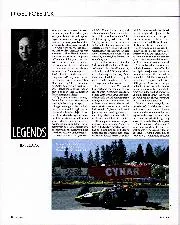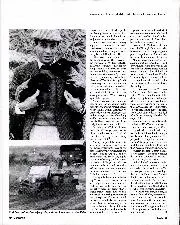The abnormal circumstance regarding Grimand, though, was that the secretary of the meetings held there was one Noreen Garvie, a cousin of Clark’s, who was keen to see her relative and his friend at one of her events. Ian agreed to enter the handicap race, and since there was no chance – how could there be ? – of Clark’s parents finding out, he quietly persuaded Jim to go out in the sports car event.
As far as results were concerned it wasn’t an auspicious day for either of them. Clark, up against Lotus Elevens and the like in a heavy, underpowered saloon car, finished well down. Scott Watson, who was rather shaken to see that in practice Clark was nearly three seconds quicker than him within five laps of leaving the pits, found that the organisers had also taken this fact on board and promptly handicapped him to smithereens.
June 16 didn’t get much better after that, either. It turned out that Clark wasn’t the only relation Noreen Garvie had attracted to Crimond. A number of other cousins were there, too, and of course they were very excited about seeing one of their clan out on the circuit. News of Clark’s exploits got back to the family home faster than the DKW did, and a reception committee was waiting for the travellers on their return. “In perfect fairness it really was a very good-natured grilling,” Ian said years later, “but I do remember taking the blame and apologising profusely.”
Not much of a day, then, but look what it led to. ‘Who was the world’s greatest racing driver?’ is a pretty fatuous question, but any attempt to answer it invariably involves mention of Clark’s name. It was the Crimond meeting that started the ball rolling – Clark’s parents could hardly object to his starting racing when he had already done so, which removed the principal obstacle to his early career.

Clark will forever be associated with Lotuses but his debut was in a humbler machine
Grand Prix Photo
He still needed an opportunity, though, and that was provided by Ian. Clark’s performance in practice was enough to convince him that he needn’t take competition driving too seriously in future, and although he was an enthusiastic racer for several years afterwards his main efforts were concentrated on helping Clark, first by continuing to lend him cars and later by acting as team manager for Jock McBain’s Border Reivers team, which was re-formed in 1958 largely as a way of pushing Clark on to greater things.
One look along the main straight, rising evocatively beyond the pits, and it all comes back
And now, with all that in mind, here we are at Crimond, celebrating in a small way that immensely significant race meeting of 40 summers ago. There are five of us present, trying to work out the old circuit layout through a maze of radio masts and wishing the wind would die down.
Apart from self and photographer, our party includes David Ross, motoring correspondent of the Aberdeen Evening Express, who has been very helpful in providing archive material, and his friend David Simon. These two visited Crimond as schoolboys, but there is an extra signficance to Simon’s presence, since he is an authority on the DKW Sonderklasse and has very kindly brought his own version along.







